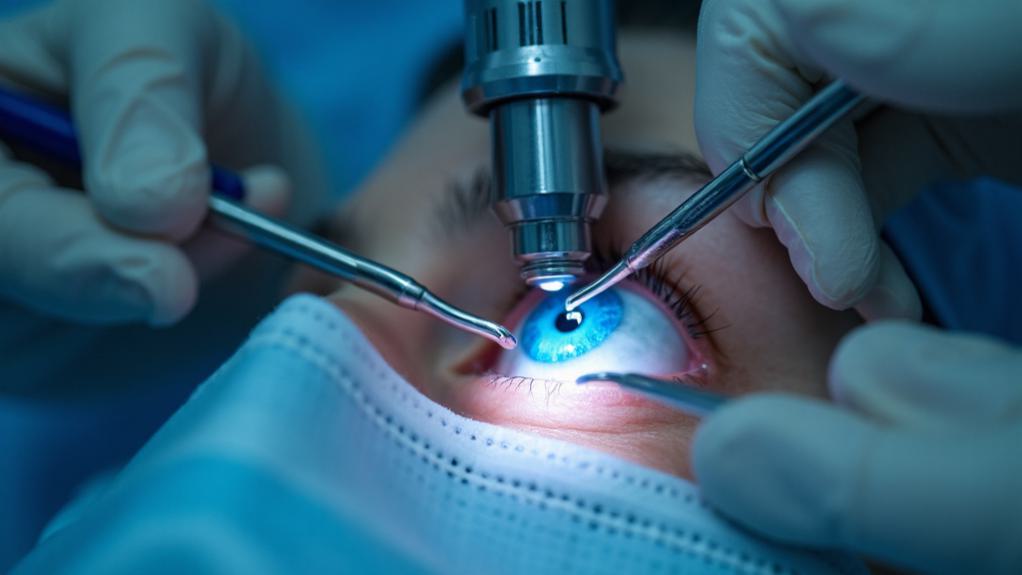Have you ever considered that a mere 10-minute procedure could permanently liberate you from the constraints of glasses or contact lenses? As you explore LASIK surgery, a sophisticated refractive technique that reshapes the cornea to address myopia, hyperopia, and astigmatism, you’ll uncover its remarkable efficacy—with over 90% of patients achieving 20/20 vision. Yet, with potential risks like dry eyes, are you prepared to weigh the benefits against the challenges?
Key Takeaways
- LASIK surgery corrects vision issues like myopia and astigmatism by reshaping the cornea.
- It offers over 90% of patients 20/20 vision or better.
- The procedure takes 10-15 minutes per eye with quick recovery.
- Costs in India range from 800-1,500 USD, much lower than Western countries.
- Risks include dry eyes and rare complications, occurring in less than 1% of cases.
Have you ever wondered how a brief surgical procedure could potentially liberate you from the constraints of glasses or contact lenses, yet carry intricate risks that demand careful consideration? LASIK surgery, a widely sought-after refractive correction method, offers the promise of enhanced visual acuity, but it is imperative that you weigh the potential complications before making a decision. Particularly for individuals with unique anatomical traits, such as those with thinner corneas often observed in Indian populations, the stakes are elevated. Research from the All India Institute of Medical Sciences (AIIMS) underscores that Indian eyes may possess corneas less robust than their Western counterparts, heightening the risk of severe outcomes like corneal ectasia—a condition where the cornea bulges abnormally—if not meticulously screened prior to surgery. Furthermore, studies at AIIMS have shown that the average corneal thickness in Indian eyes is significantly lower, at about 519 microns, compared to 557 microns in Western eyes, making thinner corneas a critical factor in surgical eligibility.
Delving deeper into the spectrum of risks, you must recognize that even with experienced surgeons, where serious complications occur in less than 1% of cases, temporary side effects are not uncommon. You might experience discomfort, vision disturbances, or persistent dry eyes post-procedure, alongside potential flap complications such as striae or dislocation. More intricate postoperative issues, including diffuse lamellar keratitis, microbial infections, epithelial ingrowth, and residual refractive errors, could also emerge, necessitating vigilant follow-up care. For those with high myopia, the removal of a substantial corneal segment poses an additional threat, potentially leading to irreversible vision loss if the structural integrity of the cornea is compromised. Additionally, it’s important to note that LASIK corrects vision by precisely reshaping cornea tissue, a process that requires advanced laser technology and skilled surgical expertise.
As you contemplate LASIK, consider the nuanced balance between its transformative potential and the inherent uncertainties. A study conducted at a tertiary center in North India revealed that while many patients report improved visual outcomes, the quality of life post-surgery hinges on individual factors and expectations. Therefore, it becomes your responsibility to engage in thorough consultations with specialists who can assess your specific corneal thickness and overall ocular health. By approaching this decision with informed caution, acknowledging both the statistical rarity of severe complications and the reality of temporary setbacks, you position yourself to make a choice that aligns with your long-term vision health and personal circumstances.
Overview
LASIK surgery, or Laser-Assisted In Situ Keratomileusis, is a popular refractive eye surgery designed to correct common vision problems such as nearsightedness (myopia), farsightedness (hyperopia), and astigmatism. These conditions occur when the shape of the cornea prevents light from focusing properly on the retina, leading to blurred vision. LASIK works by reshaping the cornea using a specialized laser, allowing light to be properly focused and thereby improving visual acuity. This procedure serves as an effective alternative to glasses or contact lenses, offering a more permanent solution for vision correction. Other treatment options for refractive errors include Photorefractive Keratectomy (PRK) and LASEK, which also reshape the cornea but differ in technique and recovery time. LASIK is typically recommended for individuals over 18 years old with stable vision prescriptions who seek to reduce or eliminate their dependence on corrective eyewear, provided they meet specific eye health criteria as determined by an ophthalmologist. The goal of LASIK is to enhance daily activities by providing clearer vision without the need for corrective lenses vision enhancement goal. During the procedure, a thin flap is created on the cornea to access and reshape the underlying tissue cornea flap creation.
Treatment Details and Key Information
LASIK surgery, a popular refractive eye surgery to correct vision issues like myopia, hyperopia, and astigmatism, is widely offered in big corporate hospitals across India, catering to foreign patients with world-class facilities and internationally trained ophthalmologists. These hospitals, such as Apollo, Fortis, and Max Healthcare, provide complete packages for international patients, including pre-surgery consultations, advanced diagnostic tests, and post-operative care, often with assistance in travel and accommodation. The procedure itself is quick, taking about 10 to 15 minutes per eye, and is typically an outpatient process, meaning no hospital stay is required; patients can return to their accommodation on the same day. Total recovery time varies, with most patients resuming normal activities within a few days, though full stabilization of vision may take a few weeks to months. LASIK procedures in India include traditional LASIK using a microkeratome for corneal flap creation, and more advanced options like Femtosecond LASIK (bladeless) which uses a laser for flap creation, offering greater precision and reduced risk of complications but at a higher cost. Additionally, customized wavefront-guided LASIK is available, tailoring the treatment to the patient’s unique eye structure for enhanced outcomes, though it is more expensive. Each method has its pros and cons: traditional LASIK is cost-effective but carries a slightly higher risk of flap-related issues, while bladeless and wavefront-guided options provide better accuracy and safety but are pricier, making the choice dependent on the patient’s needs and budget. Globally, over 40 million people have undergone LASIK from 1991 to 2016, showcasing its widespread adoption and trust among patients worldwide popularity. Extensive research, with over 7,000 studies, confirms the safety of LASIK as a reliable vision correction method.
Key Benefits & Advantages
LASIK surgery in India has emerged as a highly sought-after treatment for vision correction due to its numerous benefits and advantages. One of the primary reasons to choose this treatment in India is the combination of world-class medical facilities and highly skilled ophthalmologists who deliver exceptional care at a fraction of the cost compared to many Western countries. The success rates are impressive, with over 99% of patients achieving vision better than 20/40 and more than 90% attaining 20/20 or better, aligning with global standards. The effectiveness of LASIK is evident in its ability to provide stable, long-term vision correction, greatly reducing dependence on glasses or contact lenses. Additionally, India offers rapid recovery times, with most patients resuming normal activities within 48 hours, and the procedure is generally painless with minimal discomfort. The affordability, coupled with advanced technology and high patient satisfaction rates of around 96%, makes India an attractive destination for LASIK surgery, enhancing quality of life through improved vision and freedom from corrective devices. Furthermore, LASIK is particularly effective for correcting mild nearsightedness, yielding some of the best outcomes among refractive errors.
| Country | Average Cost of LASIK (USD) | Affordability (Relative to Income) | Additional Notes |
|---|---|---|---|
| India | 800 – 1,500 | High | Low cost with high-quality care and technology. |
| United States | 2,000 – 4,000 | Moderate | Higher costs due to advanced infrastructure. |
| United Kingdom | 2,500 – 4,500 | Moderate | Expensive but widely available. |
| Australia | 2,000 – 3,500 | Moderate | Costs vary by region and clinic. |
| Singapore | 1,500 – 3,000 | High | Competitive pricing with excellent facilities. |
Treatment Process
The LASIK surgery treatment process involves a series of meticulous steps to guarantee safety and effectiveness, beginning with thorough pre-surgery preparations and diagnostic procedures. Before the treatment, a thorough eye examination is conducted to evaluate vision and overall eye health, while a detailed review of medical and surgical history helps identify potential risks or contraindications. Specialized tests measure corneal thickness, curvature, and surface irregularities, and wavefront-guided technology creates a precise topographic map of the eye for accurate planning. Patients also engage in discussions with their surgeon to set realistic expectations, understand risks, and learn about post-surgery care. On the day of the procedure, which typically lasts under 30 minutes, numbing eye drops are applied to minimize discomfort. An eyelid holder keeps the eyes open, and a suction ring is placed to stabilize the eye. A precision instrument then creates a hinged corneal flap to access the underlying tissue, followed by the use of an excimer laser to reshape the cornea by selectively removing tissue based on the specific vision correction needed, with laser activation taking less than a minute per eye.
Expected Outcomes
LASIK surgery offers highly promising outcomes for patients seeking vision correction, with over 8 out of 10 achieving 20/40 vision or better, and approximately 62% attaining 20/20 uncorrected visual acuity. Studies indicate that 96% of eyes are within ±1.0 diopter of emmetropia, reflecting a high degree of refractive success, while about 87% are within ±0.5 diopter of the target refraction, showcasing strong predictability. Long-term effectiveness is generally robust, with most patients maintaining improved vision over extended periods, though a small percentage may experience minor regression, necessitating follow-up care to monitor stability. Success rates are impressive, with an average of 95.4% of patients worldwide reporting satisfaction with their results, and over 98.5% affirming they would make the same decision again. However, risks such as temporary haziness, blurred vision, night vision issues like glare or halos (reported in 12-57% of cases), and rare instances of double vision or quality of vision problems can occur, though serious complications remain uncommon.
After-Treatment Care & Recovery
After LASIK surgery, proper after-treatment care and recovery are essential for ideal healing and vision outcomes. Patients are typically prescribed medicated eye drops to prevent infection, reduce inflammation, and manage dryness, which is a common side effect. Regular follow-up appointments with the surgeon are vital to monitor healing progress and address any potential complications, starting as early as the day after surgery and continuing for several months. During the recovery phase, necessary precautions include wearing protective shields over the eyes immediately post-surgery to prevent accidental rubbing or bumping, avoiding strenuous activities like heavy lifting or bending for at least a few weeks, and refraining from rubbing the eyes to protect the corneal flap. Lifestyle changes may involve taking adequate rest, especially in the first 24 hours, arranging transportation since driving is prohibited initially, and limiting screen time or exposure to harsh light to reduce eye strain. Adhering to these guidelines supports a smooth recovery, with most patients noticing significant vision improvement within 24 to 48 hours and full stabilization over four to six weeks.
References
- https://timesofindia.indiatimes.com/science/laser-surgery-not-suited-for-indian-eyes/articleshow/17788521.cms
- https://heritagehospitals.com/blog/side-effects-of-lasik-eye-surgery/
- https://pmc.ncbi.nlm.nih.gov/articles/PMC10644918/
- https://www.allaboutvision.com/treatments-and-surgery/vision-surgery/lasik/lasik-risks-and-complications/
- https://journals.lww.com/ijo/fulltext/2021/07000/complications_of_laser_assisted_in_situ.9.aspx
- https://www.mayoclinic.org/tests-procedures/lasik-eye-surgery/about/pac-20384774
- https://www.aao.org/eye-health/treatments/lasik
- https://my.clevelandclinic.org/health/treatments/21805-lasik-eye-surgery
- https://www.ncbi.nlm.nih.gov/books/NBK555970/
- https://en.wikipedia.org/wiki/LASIK

